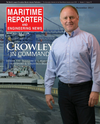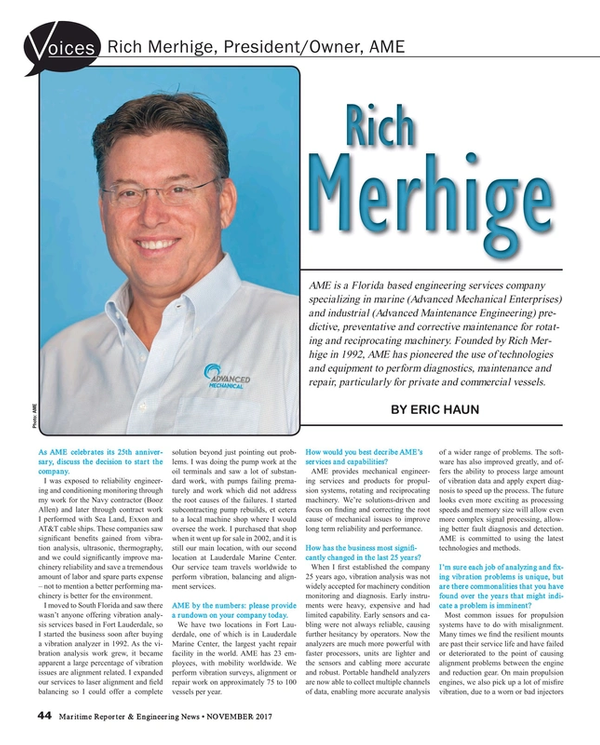
Voices: Rich Merhige, President/Owner, AME
By Eric Haun
AME is a Florida based engineering services company specializing in marine (Advanced Mechanical Enterprises) and industrial (Advanced Maintenance Engineering) predictive, preventative and corrective maintenance for rotating and reciprocating machinery. Founded by Rich Merhige in 1992, AME has pioneered the use of technologies and equipment to perform diagnostics, maintenance and repair, particularly for private and commercial vessels.
As AME celebrates its 25th anniversary, discuss the decision to start the company.
I was exposed to reliability engineering and conditioning monitoring through my work for the Navy contractor (Booz Allen) and later through contract work I performed with Sea Land, Exxon and AT&T cable ships. These companies saw significant benefits gained from vibration analysis, ultrasonic, thermography, and we could significantly improve machinery reliability and save a tremendous amount of labor and spare parts expense – not to mention a better performing machinery is better for the environment.
I moved to South Florida and saw there wasn’t anyone offering vibration analysis services based in Fort Lauderdale, so I started the business soon after buying a vibration analyzer in 1992. As the vibration analysis work grew, it became apparent a large percentage of vibration issues are alignment related. I expanded our services to laser alignment and field balancing so I could offer a complete solution beyond just pointing out problems. I was doing the pump work at the oil terminals and saw a lot of substandard work, with pumps failing prematurely and work which did not address the root causes of the failures. I started subcontracting pump rebuilds, et cetera to a local machine shop where I would oversee the work. I purchased that shop when it went up for sale in 2002, and it is still our main location, with our second location at Lauderdale Marine Center. Our service team travels worldwide to perform vibration, balancing and alignment services.
AME by the numbers: please provide a rundown on your company today.
We have two locations in Fort Lauderdale, one of which is in Lauderdale Marine Center, the largest yacht repair facility in the world. AME has 23 employees, with mobility worldwide. We perform vibration surveys, alignment or repair work on approximately 75 to 100 vessels per year.
How would you best decribe AME’s services and capabilities?
AME provides mechanical engineering services and products for propulsion systems, rotating and reciprocating machinery. We’re solutions-driven and focus on finding and correcting the root cause of mechanical issues to improve long term reliability and performance.
How has the business most significantly changed in the last 25 years?
When I first established the company 25 years ago, vibration analysis was not widely accepted for machinery condition monitoring and diagnosis. Early instruments were heavy, expensive and had limited capability. Early sensors and cabling were not always reliable, causing further hesitancy by operators. Now the analyzers are much more powerful with faster processors, units are lighter and the sensors and cabling more accurate and robust. Portable handheld analyzers are now able to collect multiple channels of data, enabling more accurate analysis of a wider range of problems. The software has also improved greatly, and offers the ability to process large amount of vibration data and apply expert diagnosis to speed up the process. The future looks even more exciting as processing speeds and memory size will allow even more complex signal processing, allowing better fault diagnosis and detection. AME is committed to using the latest technologies and methods.
I’m sure each job of analyzing and fixing vibration problems is unique, but are there commonalities that you have found over the years that might indicate a problem is imminent?
Most common issues for propulsion systems have to do with misalignment. Many times we find the resilient mounts are past their service life and have failed or deteriorated to the point of causing alignment problems between the engine and reduction gear. On main propulsion engines, we also pick up a lot of misfire vibration, due to a worn or bad injectors and torsional vibration due to a torsional coupling which is beyond its service life, has failed or is about to.
Can you describe one problem that you found most challenging to solve, with insights on how the problem was detected, analyzed and fixed?
One of my first customers was a large, well-known cruise line. It was their flagship vessel, the first one they had built, and they had a complaint about a loud high pitch noise coming from the shaftline, following a dry docking, which they perceived as being a defective shaft bearing. I attended the vessel and was able to immediately diagnose it as a “singing” propeller. The propeller blade resonance was being excited by the vortices coming off the trailing edge of the blades. I recommended the divers grind an anti singing edge on the blades, which corrected the problem. However, while I was there, I noticed an exceptional and extreme vibration coming from the shaft generators which were driven by a pinion shaft which was integral with the propeller shafting. I came to find out that this had been an issue since the vessel was built, and resulted in catastrophic failures of the pinon shaft, rendering the shaftline inoperable and involving costly and time-consuming repairs. Vibration analysis showed a structural resonance problem of the propeller line shaft bearings. Further inspection revealed that additional structural reinforcement was needed in the double bottom to stiffen the tank top where the bearings were mounted. We were able to work together with a ship repair firm that welded in the appropriate structure while we monitored the position of the shaft bearings with precision lasers, so to maintain the shaft alignment and control the welding heat distortion. The result was a significant drop in vibration of the line shaft bearings and a happy and impressed customer.
What do you consider to be your biggest challenge in running an efficient, profitable business?
We are in a technology intensive business, using lasers alignment systems and vibration analysis equipment and software that requires an investment in both in equipment and training. We are constantly upgrading and purchasing new equipment to better our services. It is both challenging and exciting to be on the leading edge, but there is a huge learning curve when becoming proficient in the services we provide and equipment we use. It’s not something that’s taught in the classroom. It requires a combination of knowledge, training and hands-on, real world experience.
Looking back on the first quarter century in business, in what do you take the most satisfaction, and why?
It is rewarding as an engineer to diagnosis and solve complex vibration problems. It is also very rewarding to mentor our younger employees. Sometimes it takes perseverance, but with 25 years of business and experience behind us, we have been able to solve a lot of problems with the resources available to us and improve our customers operations and maintenance.
(As published in the November 2017 edition of Maritime Reporter & Engineering News)
Read Voices: Rich Merhige, President/Owner, AME in Pdf, Flash or Html5 edition of November 2017 Maritime Reporter
Other stories from November 2017 issue
Content
- The Challenge of Marine Asset Appraisal page: 12
- US Navy: Back to Basics page: 16
- The Best Options for Safe Mooring page: 18
- Deck Machinery: Five Stress Areas page: 20
- Five Requirements for Safe Ops page: 22
- How Augmented Reality Technology Could Transform Shipping page: 26
- Eye on Design: C-DRONE page: 28
- IMO Orders Fuels of the Future page: 30
- Voices: Howard Fireman, SVP & CTO, ABS page: 32
- Inside the World's First LNG Containership Conversion page: 36
- Voices: Paul Smulders, CEO, Radio Holland page: 42
- Voices: Rich Merhige, President/Owner, AME page: 44
- A New Breed of Tug page: 54
- Wind Energy Workboats: A US Offshore Build-up page: 60
- Bouchard Set to Celebrate a Century page: 66
- Strategic Marine: Innovative Quality page: 67
- Interferry: Diverse Operations Common Successes page: 68
- Voices: Paulo Cesar P. Freitas, Norsul page: 72
- Managing the New Panamax Containerships page: 80
- Coatings & Corrosion Control Take Center Stage page: 84
- W&O Supply Holds a Steady Course page: 90


